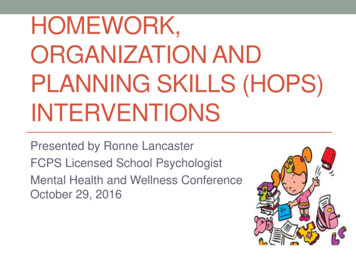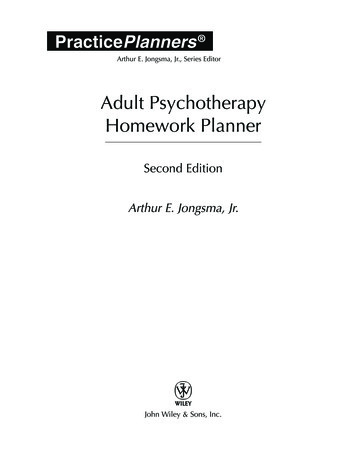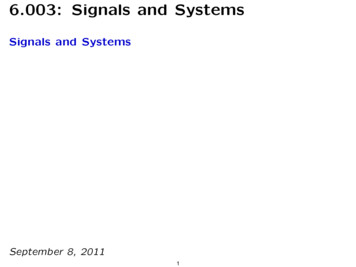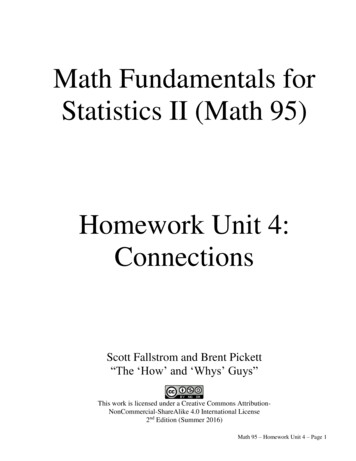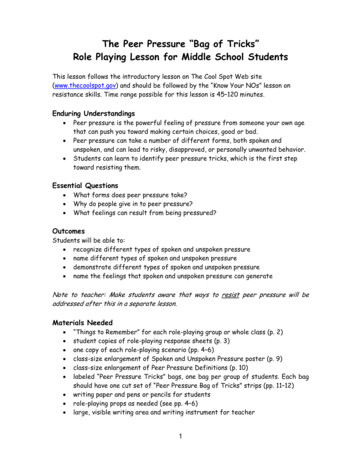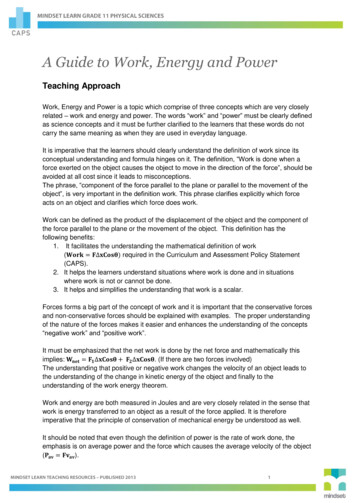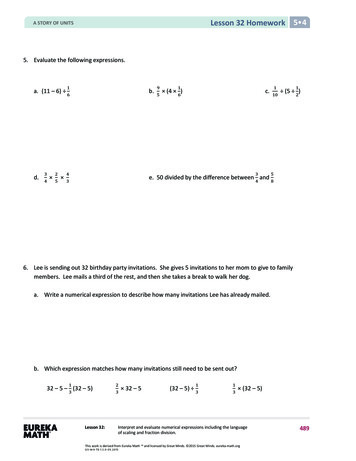
Transcription
Lesson 32 Homework 5 4A STORY OF UNITS5. Evaluate the following expressions.a. (11 – 6) d.34 25 16b.43e. 50 divided by the difference between and516 (4 )c.3411012 (5 )586. Lee is sending out 32 birthday party invitations. She gives 5 invitations to her mom to give to familymembers. Lee mails a third of the rest, and then she takes a break to walk her dog.a. Write a numerical expression to describe how many invitations Lee has already mailed.b. Which expression matches how many invitations still need to be sent out?1332 – 5 – (32 – 5)Lesson 32:23 32 – 5(32 – 5) 1313 (32 – 5)Interpret and evaluate numerical expressions including the languageof scaling and fraction division.This work is derived from Eureka Math and licensed by Great Minds. 2015 Great Minds. eureka-math.orgG 5-M 4-TE-1.3.0 -0 5.20 15489
Lesson 33 5 4A STORY OF UNITSLesson 33Objective: Create story contexts for numerical expressions andtape diagrams, and solve word problems.Suggested Lesson StructureFluency PracticeConcept DevelopmentStudent Debrief(12 minutes)(38 minutes)(10 minutes)Total Time(60 minutes)Fluency Practice (12 minutes)Sprint: Divide Decimals 5.NBT.7(8 minutes)Write Equivalent Expressions 5.OA.1(4 minutes)Sprint: Divide Decimals (8 minutes)Materials: (S) Divide Decimals SprintNote: This fluency activity reviews Lessons 29–32.Write Equivalent Expressions (4 minutes)Materials: (S) Personal white boardNote: This fluency activity reviews Lesson 32.1313T:(Write 2 .) What is 2 ?S:6.T:(Write 2 4 .) On your personal white board, write the complete13number sentence.S:13(Write 2 4. Beneath it, write 6 4. Beneath it, write 10.)Continue with the following possible sequence:Lesson 33:5 3 1,5 31425 (2 2), (4 3) , and ( –3)10Create story contexts for numerical expressions and tape diagrams,and solve word problems.This work is derived from Eureka Math and licensed by Great Minds. 2015 Great Minds. eureka-math.orgG 5-M 4-TE-1.3.0 -0 5.20 15 5.490
Lesson 33 5 4A STORY OF UNITSConcept Development (38 minutes)Materials: (S) Problem SetNote: The time normally allotted for the Application Problem has been included in the Concept Developmentportion of today’s lesson to give students the time necessary to write story problems.Suggested Delivery of Instruction for Solving Lesson 33 Word Problems1. Model the problem.Have two pairs of student work at the board while the otherswork independently or in pairs at their seats. Review thefollowing questions before beginning the first problem:Can you draw something?What can you draw?What conclusions can you make from your drawing?As students work, circulate. Reiterate the questions above.After two minutes, have the two pairs of students share onlytheir labeled diagrams. For about one minute, have thedemonstrating students receive and respond to feedback andquestions from their peers.2. Calculate to solve and write a statement.NOTES ONMULTIPLE MEANSOF ENGAGEMENT:Consider selecting students who mayhave difficulty grasping the ProblemSet to work at the board. Supportthem as they work, and praise theireffort and perseverance. Thisapproach can help improve classroomclimate, where top students are usuallyselected to work at the board, andreinforce the notion thatdetermination and persistence are keyto learning math skills.Give everyone two minutes to finish work on that question,sharing their work and thinking with a peer. All should writetheir equations and statements of the answer.3. Assess the solution for reasonableness.Give students one to two minutes to assess and explain the reasonableness of their solution.Problem 112Ms. Hayes has liter of juice. She distributes it equally to 6 students in her tutoring group.a. How many liters of juice does each student get?Lesson 33:Create story contexts for numerical expressions and tape diagrams,and solve word problems.This work is derived from Eureka Math and licensed by Great Minds. 2015 Great Minds. eureka-math.orgG 5-M 4-TE-1.3.0 -0 5.20 15491
Lesson 33 5 4A STORY OF UNITSb. How many more liters of juice will Ms. Hayes need if she wants to give each of the 24 students in herclass the same amount of juice found in Part (a)?In this problem, Ms. Hayes is sharing equally, or dividing, one-half liter of juice among 6 students. Students1should recognize this problem as 2 6. A tape diagram shows that when halves are partitioned into 6 equalparts, twelfths are created. Likewise, the diagram shows that 1 half is equal to 6 twelfths, and when writtenin unit form, 6 twelfths divided by 6 is a simple problem. Each student receives one-twelfth liter of juice. In1Part (b), students must find how much more juice is necessary to give a total of 24 students 12 liter of juice.Some students may choose to solve by multiplying 24 by one-twelfth to find that a total of 2 liters of juice isnecessary. Encourage interpretation as a scaling problem. Help students see that, since 24 students is 4times more students than 6 students, Ms. Hayes will need 4 times more juice as well. 4 times one-half is,1again, equal to 2 liters of juice. Either way, Ms. Hayes will need 1 more liters of juice.2Problem 21Lucia has 3.5 hours left in her workday as a car mechanic. Lucia needs of an hour to complete one oil2change.a. How many oil changes can Lucia complete during the rest of her workday?b. Lucia can complete two car inspections in the same amount of time it takes her to complete one oilchange. How long does it take her to complete one car inspection?c. How many inspections can she complete in the rest of her workday?Lesson 33:Create story contexts for numerical expressions and tape diagrams,and solve word problems.This work is derived from Eureka Math and licensed by Great Minds. 2015 Great Minds. eureka-math.orgG 5-M 4-TE-1.3.0 -0 5.20 15492
Lesson 33 5 4A STORY OF UNITSIn Part (a), students are asked to find how many half-hours are in a 3.5-hour period. The presence of bothdecimal and fraction notation in these problems adds a layer of complexity. Students should be comfortablechoosing which form of fractional number is most efficient for solving. This will vary by problem and, in many1cases, by student. In this problem, many students may prefer to deal with 3.5 as a mixed number (3 ). Then,121a tape diagram clearly shows that 3 can be partitioned into 7 units of . Others may prefer to express the22half hour as 0.5. Still, others may begin their thinking with, “How many halves are in 1 whole?” and continuewith similar prompts to find how many halves are in 3 wholes and 1 half.In Part (b), students reason that since Lucia can complete 2inspections in the time it takes her to complete just one oil1change, may be divided by 2 to find the fraction of an hour2that an inspection requires. Students may also reason thatthere are two 15-minute units in one half-hour period, and1therefore, Lucia can complete an inspection in hour.4In Part (c), a variety of approaches are also possible. Some mayargue that, since Lucia can work twice as fast completinginspections, they need only to double the number of oil changesMP.7she could complete in 3.5 hours to find the number ofinspections done. This type of thinking is evidence of a deeperunderstanding of a scaling principle. Other students may solve1Part (c), just as they did Part (a), but using a divisor of . In4either case, Lucia can complete 14 inspections in 3.5 hours.Lesson 33:NOTES ONMULTIPLE MEANSOF ENGAGEMENT:Challenge high-achieving students(who may also be early finishers) tosolve the problems more than oneway. After looking at their work,challenge them by specifying theoperation they must use to begin, orchange the path of their approach byrequiring a certain operation withintheir solution.Challenge them further by asking themto use the same general context but towrite a different question that resultsin the same answer as that obtainedfor the original problem.Create story contexts for numerical expressions and tape diagrams,and solve word problems.This work is derived from Eureka Math and licensed by Great Minds. 2015 Great Minds. eureka-math.orgG 5-M 4-TE-1.3.0 -0 5.20 15493
Lesson 33 5 4A STORY OF UNITSProblem 3Carlo buys 14.40 worth of grapefruit. Each grapefruit costs 0.80.a. How many grapefruits does Carlo buy?b. At the same store, Kahri spends one-third as much money on grapefruit as Carlo. How manygrapefruits does she buy?Students divide a decimal dividend by a decimal divisor to solve Problem 3. This problem is made simpler by10100showing the division expression as a fraction. Then, multiplication by a fraction equal to 1 ( or ,10100depending on whether 80 cents is expressed as 0.8 or 0.80) results in both a whole number divisor anddividend. From here, students must divide 144 by 8 to find a quotient of 18. Carlo buys 18 grapefruits withhis money.In Part (b), since Kahri spends one-third of her money on equally priced grapefruit, students should reasonthat she would be buying one-third the number of fruit. Therefore, 18 3 shows that Kahri buys 6 grapefruit.Students may also choose the far less-direct method of solving a third of 14.40 and dividing that number( 4.80) by 0.80 to find the number of grapefruits purchased by Kahri.Problem 4Studies show that a typical giant hummingbird can flap its wings once in 0.08 of a second.a. While flying for 7.2 seconds, how many times will a typical giant hummingbird flap its wings?b. A ruby-throated hummingbird can flap its wings 4 times faster than a giant hummingbird. How manytimes will a ruby-throated hummingbird flap its wings in the same amount of time?Lesson 33:Create story contexts for numerical expressions and tape diagrams,and solve word problems.This work is derived from Eureka Math and licensed by Great Minds. 2015 Great Minds. eureka-math.orgG 5-M 4-TE-1.3.0 -0 5.20 15494
Lesson 33 5 4A STORY OF UNITSProblem 4 is another decimal divisor/dividend problem. Similarly, students should express this division as afraction and then multiply to rename the divisor as a whole number. Ultimately, students should find that thegiant hummingbird can flap its wings 90 times in 7.2 seconds. Part (b) is another example of the usefulness ofthe scaling principle. Since a ruby-throated hummingbird can flap its wings 4 times faster than the gianthummingbird, students need only multiply 90 by 4 to find that a ruby-throated hummingbird can flap itswings a remarkable 360 times in 7.2 seconds. Though not very efficient, students could also divide 0.08 by 4to find that it takes a ruby-throated hummingbird just 0.02 seconds to flap its wings once. Then, division of7.2 by 0.02 (or 720 by 2, after renaming the divisor as a whole number) yields a quotient of 360.Problem 5Create a story context for the following expression.13 ( 20 – 3.20)Working backward from expression to story may be challengingfor some students. Since the expression given containsparentheses, the story created must first involve the subtractionof 3.20 from 20. For students in need of assistance, drawinga tape diagram first may be of help. Note that the story of Jamis1interprets the multiplication of directly, whereas the story of3Wilma interprets the expression as division by 3.Problem 6Create a story context about painting a wall for the followingtape diagram.1NOTES ONMULTIPLE MEANSOF ENGAGEMENT:Challenge early finishers in this lessonby encouraging them to go back toeach problem and provide an alternatemeans for solution or an additionalmodel to represent the problem.Students could discuss how theirinterpretation of each problem ledthem to solve it the way they did, andhow and why alternate interpretationscould lead to a different solutionstrategy.?Lesson 33:Create story contexts for numerical expressions and tape diagrams,and solve word problems.This work is derived from Eureka Math and licensed by Great Minds. 2015 Great Minds. eureka-math.orgG 5-M 4-TE-1.3.0 -0 5.20 15495
Lesson 33 5 4A STORY OF UNITSAgain, students are asked to create a story problem, this time using a given tape diagram and the context ofpainting a wall. The challenge here is that this tape diagram implies a two-step word problem. The whole, 1,is first partitioned into half, and then one of those halves is divided into thirds. The story students createshould reflect this two-part drawing. Students should be encouraged to share aloud and discuss their storiesand thought process for solving.Student Debrief (10 minutes)Lesson Objective: Create story contexts for numericalexpressions and tape diagrams, and solve word problems.The Student Debrief is intended to invite reflection andactive processing of the total lesson experience.Invite students to review their solutions for the ProblemSet. They should check work by comparing answers with apartner before going over answers as a class. Look formisconceptions or misunderstandings that can beaddressed in the Debrief. Guide students in aconversation to debrief the Problem Set and process thelesson.Any combination of the questions below may be used tolead the discussion.For Problems 1–5, did you draw a tape diagramto help solve the problems? If so, share yourdrawings and explain them to a partner.For Problems 1–4, there are different ways tosolve the problems. Share and compare yourstrategy with a partner.For Problems 5 and 6, share your story problem with a partner. Explain how you interpreted theexpression in Problem 5 and the tape diagram in Problem 6.Lesson 33:Create story contexts for numerical expressions and tape diagrams,and solve word problems.This work is derived from Eureka Math and licensed by Great Minds. 2015 Great Minds. eureka-math.orgG 5-M 4-TE-1.3.0 -0 5.20 15496
Lesson 33 5 4A STORY OF UNITSExit Ticket (3 minutes)After the Student Debrief, instruct students to completethe Exit Ticket. A review of their work will help withassessing students’ understanding of the concepts thatwere presented in today’s lesson and planning moreeffectively for future lessons. The questions may be readaloud to the students.Lesson 33:Create story contexts for numerical expressions and tape diagrams,and solve word problems.This work is derived from Eureka Math and licensed by Great Minds. 2015 Great Minds. eureka-math.orgG 5-M 4-TE-1.3.0 -0 5.20 15497
Lesson 33 Sprint 5 4A STORY OF UNITSNumber Correct:ADivide Decimals1.1 1 23.5 0.1 2.1 0.1 24.0.5 0.1 3.2 0.1 25.0.05 0.1 4.7 0.1 26.0.08 0.1 5.1 0.1 27.4 0.01 6.10 0.1 28.40 0.01 7.20 0.1 29.47 0.01 8.60 0.1 30.59 0.01 9.1 1 31.3 0.1 10.1 0.1 32.30 0.1 11.10 0.1 33.32 0.1 12.100 0.1 34.32.5 0.1 13.200 0.1 35.25 5 14.800 0.1 36.2.5 0.5 15.1 0.1 37.2.5 0.05 16.1 0.01 38.3.6 0.04 17.2 0.01 39.32 0.08 18.9 0.01 40.56 0.7 19.5 0.01 41.77 1.1 20.50 0.01 42.4.8 0.12 21.60 0.01 43.4.84 0.4 22.20 0.01 44.9.63 0.03 Lesson 33:Create story contexts for numerical expressions and tape diagrams,and solve word problems.This work is derived from Eureka Math and licensed by Great Minds. 2015 Great Minds. eureka-math.orgG 5-M 4-TE-1.3.0 -0 5.20 15498
Lesson 33 Sprint 5 4A STORY OF UNITSNumber Correct:BImprovement:Divide Decimals1.10 1 23.4 0.1 2.1 0.1 24.0.4 0.1 3.2 0.1 25.0.04 0.1 4.8 0.1 26.0.07 0.1 5.1 0.1 27.5 0.01 6.10 0.1 28.50 0.01 7.20 0.1 29.53 0.01 8.70 0.1 30.68 0.01 9.1 1 31.2 0.1 10.1 0.1 32.20 0.1 11.10 0.1 33.23 0.1 12.100 0.1 34.23.6 0.1 13.200 0.1 35.15 5 14.900 0.1 36.1.5 0.5 15.1 0.1 37.1.5 0.05 16.1 0.01 38.3.2 0.04 17.2 0.01 39.28 0.07 18.7 0.01 40.42 0.6 19.4 0.01 41.88 1.1 20.40 0.01 42.3.6 0.12 21.50 0.01 43.3.63 0.3 22.80 0.01 44.8.44 0.04 Lesson 33:Create story contexts for numerical expressions and tape diagrams,and solve word problems.This work is derived from Eureka Math and licensed by Great Minds. 2015 Great Minds. eureka-math.orgG 5-M 4-TE-1.3.0 -0 5.20 15499
Lesson 33 Problem Set 5 4A STORY OF UNITSNameDate121. Ms. Hayes has liter of juice. She distributes it equally to 6 students in her tutoring group.a. How many liters of juice does each student get?b. How many more liters of juice will Ms. Hayes need if she wants to give each of the 24 students in herclass the same amount of juice found in Part (a)?122. Lucia has 3.5 hours left in her workday as a car mechanic. Lucia needs of an hour to complete one oilchange.a. How many oil changes can Lucia complete during the rest of her workday?b. Lucia can complete two car inspections in the same amount of time it takes her to complete one oilchange. How long does it take her to complete one car inspection?c. How many inspections can she complete in the rest of her workday?Lesson 33:Create story contexts for numerical expressions and tape diagrams,and solve word problems.This work is derived from Eureka Math and licensed by Great Minds. 2015 Great Minds. eureka-math.orgG 5-M 4-TE-1.3.0 -0 5.20 15500
Lesson 33 Problem Set 5 4A STORY OF UNITS3. Carlo buys 14.40 worth of grapefruit. Each grapefruit costs 0.80.a. How many grapefruits does Carlo buy?b. At the same store, Kahri spends one-third as much money on grapefruits as Carlo. How manygrapefruits does she buy?4. Studies show that a typical giant hummingbird can flap its wings once in 0.08 of a second.a. While flying for 7.2 seconds, how many times will a typical giant hummingbird flap its wings?b. A ruby-throated hummingbird can flap its wings 4 times faster than a giant hummingbird. How manytimes will a ruby-throated hummingbird flap its wings in the same amount of time?Lesson 33:Create story contexts for numerical expressions and tape diagrams,and solve word problems.This work is derived from Eureka Math and licensed by Great Minds. 2015 Great Minds. eureka-math.orgG 5-M 4-TE-1.3.0 -0 5.20 15501
Lesson 33 Problem Set 5 4A STORY OF UNITS5. Create a story context for the following expression.1 3( 20 – 3.20)6. Create a story context about painting a wall for the following tape diagram.1?Lesson 33:Create story contexts for numerical expressions and tape diagrams,and solve word problems.This work is derived from Eureka Math and licensed by Great Minds. 2015 Great Minds. eureka-math.orgG 5-M 4-TE-1.3.0 -0 5.20 15502
Lesson 33 Exit Ticket 5 4A STORY OF UNITSNameDateAn entire commercial break is 3.6 minutes.a. If each commercial takes 0.6 minutes, how many commercials will be played?b. A different commercial break of the same length plays commercials half as long. How manycommercials will play during this break?Lesson 33:Create story contexts for numerical expressions and tape diagrams,and solve word problems.This work is derived from Eureka Math and licensed by Great Minds. 2015 Great Minds. eureka-math.orgG 5-M 4-TE-1.3.0 -0 5.20 15503
Lesson 33 Homework 5 4A STORY OF UNITSNameDate1. Chase volunteers at an animal shelter after school, feeding and playing with the cats.a. If he can make 5 servings of cat food from a third of a kilogram of food, how much does one servingweigh?b. If Chase wants to give this same serving size to each of 20 cats, how many kilograms of food will heneed?2. Anouk has 4.75 pounds of meat. She uses a quarter pound of meat to make one hamburger.a. How many hamburgers can Anouk make with the meat she has?b. Sometimes Anouk makes sliders. Each slider is half as much meat as is used for a regular hamburger.How many sliders could Anouk make with the 4.75 pounds?Lesson 33:Create story contexts for numerical expressions and tape diagrams,and solve word problems.This work is derived from Eureka Math and licensed by Great Minds. 2015 Great Minds. eureka-math.orgG 5-M 4-TE-1.3.0 -0 5.20 15504
Lesson 33 Homework 5 4A STORY OF UNITS3. Ms. Geronimo has a 10 gift certificate to her local bakery.a. If she buys a slice of pie for 2.20 and uses the rest of the gift certificate to buy chocolate macaroonsthat cost 0.60 each, how many macaroons can Ms. Geronimo buy?b. If she changes her mind and instead buys a loaf of bread for 4.60 and uses the rest to buy cookies1that cost 1 2 times as much as the macaroons, how many cookies can she buy?4. Create a story context for the following expressions.14184.80.8a. (5 – 2 ) 4b. 4 ( )5. Create a story context for the following tape diagram.6?Lesson 33:Create story contexts for numerical expressions and tape diagrams,and solve word problems.This work is derived from Eureka Math and licensed by Great Minds. 2015 Great Minds. eureka-math.orgG 5-M 4-TE-1.3.0 -0 5.20 15505
This work is derived from Eureka Math and licensed by Great Minds. 2015 Great Minds. eureka-math.org G5-M4-TE-1.3.0-05.2015. Lesson 33 5 4 . Lucia has 3.5 hours left in her workday as a car mechanic. Lucia needs 1 2 of an hour to complete one oil change. a. How many oil c

